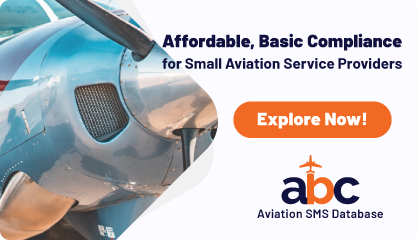Maximizing Aviation Safety

In the fast-paced skies of aviation, ensuring safety is the ultimate mission. Aviation safety managers and accountable executives are tasked with ensuring that Safety Management Systems (SMS) are
- robust,
- proactive, and
- continuously improving.
One often underutilized yet powerful tool in this endeavor is soliciting feedback from passengers and stakeholders. By integrating passenger and stakeholder input into aviation SMS, organizations can enhance risk identification, improve safety culture, and boost operational efficiency.
This article explores the benefits of gathering feedback, outlines practical processes for implementation, and provides actionable strategies to make feedback a cornerstone of your aviation safety program.
Why Feedback Matters in Aviation Safety Management
Aviation SMS is a systematic top-down approach to managing safety risks, as mandated by the International Civil Aviation Organization (ICAO) and national aviation authorities like the FAA. It relies on four pillars: Safety Policy, Safety Risk Management, Safety Assurance, and Safety Promotion. Feedback from passengers and stakeholders directly supports these pillars by providing real-world insights into potential hazards, operational gaps, and opportunities for improvement.
Key Benefits of Soliciting Feedback
- Enhanced Hazard Identification
Passengers and stakeholders, including cabin crew, ground staff, and maintenance teams, interact with aviation operations daily. Their observations can reveal hazards that may not be captured through formal audits or incident reports. For example, passengers might notice recurring issues like cabin equipment malfunctions, while ground staff could report unsafe ramp conditions. These insights feed into the Safety Risk Management process, enabling proactive hazard mitigation. - Improved Safety Culture
A strong safety culture thrives on open communication and trust. Encouraging feedback demonstrates that the organization values input from all levels, fostering a "just culture" where individuals feel safe to report concerns without fear of reprisal. This aligns with the Safety Promotion pillar, reinforcing a shared commitment to safety. - Increased Passenger Satisfaction
Passengers who feel heard are more likely to trust the airline’s commitment to safety and service. Addressing their feedback not only mitigates safety risks but also enhances the customer experience, leading to higher loyalty and positive brand perception. - Regulatory Compliance and Audit Readiness
Regulators expect SMS to incorporate feedback mechanisms to ensure continuous improvement. Documented feedback processes demonstrate compliance with ICAO Annex 19 and national regulations, making audits smoother and showcasing a proactive safety approach. - Data-Driven Decision Making
Feedback provides qualitative and quantitative data that can be analyzed to identify trends, prioritize resources, and measure the effectiveness of safety interventions. This supports the Safety Assurance pillar by validating risk controls and SMS performance.
Related Aviation SMS Performance Trending Articles
- How to Prepare Data for Trend Analysis in Risk Management Programs
- Six Steps How to Perform Trend Analysis in Aviation SMS
- How to Use Trending Charts in Aviation SMS
Challenges in Gathering Feedback

While the benefits are clear, soliciting feedback in aviation SMS comes with challenges. Passengers may be reluctant to report issues due to inconvenience or lack of awareness, while stakeholders like employees might fear repercussions. Additionally, managing large volumes of feedback can strain resources, and poorly designed feedback systems may yield low-quality data. Overcoming these challenges requires a structured, intentional approach to feedback collection and management.
Processes for Soliciting Passenger and Stakeholder Feedback
To effectively integrate feedback into your aviation SMS, follow these five key processes. Each step is designed to maximize participation, ensure data quality, and align with SMS objectives.
1. Design Accessible Feedback Channels
The first step is to create user-friendly, accessible channels for passengers and stakeholders to share their observations. These channels should be diverse to accommodate different preferences and contexts.
-
Passenger Feedback Channels
- Mobile Apps and Websites: Embed feedback forms in the airline’s app or website, with clear prompts like “Report a Safety Concern” or “Share Your Experience.” Ensure forms are mobile-optimized and available in multiple languages.
- In-Flight Systems: Use seatback entertainment systems to offer digital feedback options during flights.
- Post-Flight Surveys: Send targeted email or SMS surveys after flights, focusing on safety-related questions (e.g., “Did you observe any safety issues during your flight?”).
- QR Codes: Place QR codes on boarding passes or in cabins, linking to feedback forms.
-
Stakeholder Feedback Channels
- Anonymous Reporting Systems: Implement confidential reporting tools, such as web portals or mobile apps, for employees to report safety concerns without fear of retaliation.
- Safety Meetings and Briefings: Encourage open discussions during pre-shift briefings or safety committee meetings, with clear protocols for submitting feedback.
- Suggestion Boxes: Place physical or digital suggestion boxes in crew rooms, maintenance hangars, and ground operations areas.
Best Practice: Ensure all channels are branded with a safety-focused message, such as “Your Input Keeps Us Safe,” to emphasize the importance of feedback in SMS.
2. Promote Feedback Participation
To maximize response rates, actively promote feedback opportunities and educate passengers and stakeholders about their role in safety.
-
Passenger Engagement
- Use in-flight announcements, safety videos, or social media campaigns to encourage passengers to report safety observations. Highlight how their feedback contributes to safer skies.
- Offer incentives, such as loyalty points or small discounts, for completing safety-focused surveys (while ensuring incentives don’t compromise data integrity).
-
Stakeholder Engagement
- Train managers to model feedback-friendly behavior, reinforcing that all input is valued.
- Incorporate feedback training into onboarding and recurrent SMS training, emphasizing its role in hazard identification and risk management.
- Celebrate success stories where employee feedback led to safety improvements, such as through internal newsletters or recognition programs.
Best Practice: Regularly communicate how feedback has been used to improve safety, closing the loop and motivating continued participation.
Related Aviation Safety Culture Articles
- 3 Reasons Why Aviation Safety Culture Leads Directly to Safety Performance
- 5 Indicators of Reactive or Proactive Safety Culture in Your Aviation SMS
- 5 Simple Tips to Improve Aviation Safety Reporting Cultures
3. Structure Feedback for Actionable Insights
Feedback must be structured to yield actionable data that integrates seamlessly into SMS processes. Use targeted questions and categorization to streamline analysis.
-
Passenger Feedback
- Ask specific questions, such as: “Did you notice any issues with cabin equipment, such as seats or overhead bins?” or “Did you experience turbulence or other safety concerns during the flight?”
- Include dropdown menus or checkboxes to categorize feedback (e.g., “Cabin Safety,” “Ground Operations,” “Flight Experience”).
-
Stakeholder Feedback
- Provide templates for reporting hazards, including fields for location, time, description, and potential impact.
- Use standardized risk assessment scales (e.g., likelihood and severity) to prioritize feedback for Safety Risk Management.
Best Practice: Leverage SMS database software to automate feedback categorization and routing, ensuring it reaches the right team for analysis and action. SMS database software reduces the workload for future trend analysis.
Related Aviation SMS Database Articles
- 3 Benefits of Aviation Safety Management System (SMS) Databases
- 5 Most Important Things to Know Before Buying Aviation SMS Database
- How Long to Switch to New Aviation SMS Database?
4. Analyze and Integrate Feedback Into Aviation SMS

Once collected, feedback must be analyzed and integrated into the aviation SMS framework to drive safety improvements.
-
Data Analysis
- Use SMS software with automated data analytics tools to identify trends, such as recurring issues with specific aircraft types or operational phases (e.g., taxiing, boarding).
- Cross-reference feedback with incident reports, audit findings, and safety performance indicators to validate findings.
-
Risk Assessment
- Feed feedback into the Safety Risk Management process by conducting hazard analyses and updating risk registers. For example, if passengers frequently report loose overhead bins, assess the risk and implement corrective actions.
- Assign risk priorities based on severity and likelihood, ensuring high-priority issues are addressed promptly.
-
Action Planning
- Develop corrective and preventive actions based on feedback analysis. For instance, stakeholder feedback about slippery ramps might lead to new anti-slip measures.
- Assign responsibilities and timelines for action implementation, tracking progress through SMS dashboards.
Best Practice: Establish a feedback review committee, including safety managers, operational leaders, and employee representatives, to ensure thorough analysis and accountability.
Related Articles on Corrective and Preventive Actions (CPAs) in Aviation SMS
- What Is a Corrective Action in Aviation SMS?
- Tips Tying Corrective Action Preventive Action to Hazard Register
- All Corrective Preventative Actions Not Created Equal: Initial Mitigating Actions
5. Monitor and Communicate Outcomes
Continuous improvement requires monitoring the effectiveness of feedback-driven actions and communicating outcomes to stakeholders.
-
Monitoring
- Use Safety Assurance processes, such as audits and performance metrics, to evaluate whether feedback-driven interventions reduce risks.
- Track feedback volume and quality over time to assess the effectiveness of collection channels.
-
Communication
- Share success stories with passengers via email updates or social media, such as “Thanks to your feedback, we’ve upgraded our cabin safety checks.”
- Provide regular updates to employees through safety bulletins or meetings, highlighting how their input has strengthened SMS.
Best Practice: Publish an annual SMS report summarizing feedback trends, actions taken, and safety improvements, reinforcing transparency and trust.
Overcoming Common Feedback Challenges
To ensure feedback processes are effective, address these common pitfalls:
- Low Participation: Combat apathy by simplifying feedback forms, offering incentives, and promoting a safety-first culture.
- Data Overload: Use SMS software with filtering and prioritization features to manage large feedback volumes.
- Resistance to Change: Engage leadership to champion feedback initiatives, demonstrating top-down commitment to SMS.
- Quality Issues: Provide clear instructions and examples to guide respondents toward actionable, safety-focused input.
Case Study: Feedback in Action
Consider a regional airline that implemented a passenger feedback campaign after noticing an increase in minor cabin incidents. By adding a “Report Safety Concerns” button to their mobile app and promoting it via in-flight announcements, they collected over 500 responses in three months.
Analysis revealed recurring issues with overhead bin latches on a specific aircraft type. The airline conducted a risk assessment, implemented maintenance checks, and trained cabin crew on proper bin securing. Within six months, cabin-related incidents dropped by 30%, and passenger satisfaction scores improved due to visible safety enhancements.
Conclusion: Building a Feedback-Driven SMS
Soliciting passenger and stakeholder feedback is not just a regulatory checkbox—it’s a strategic asset for aviation safety managers and accountable executives. By designing accessible channels, promoting participation, structuring feedback for action, and integrating it into SMS processes, organizations can unlock a wealth of safety insights. The result is a stronger safety culture, reduced risks, and enhanced passenger trust.
Start small by piloting a feedback channel, such as a digital survey or anonymous reporting tool, and scale up as you refine your processes. With commitment and structure, feedback can transform your SMS into a dynamic, responsive system that keeps safety first.
Call to Action: Ready to elevate your aviation SMS? Review your current feedback mechanisms and implement one new channel this quarter. Share your success stories with your team to inspire a culture of safety and continuous improvement.
Need secure, public issue reporting tools? SMS Pro's Public Issue Reporting Tool can be branded with your logo to inspire passenger confidence and promote your brand.






